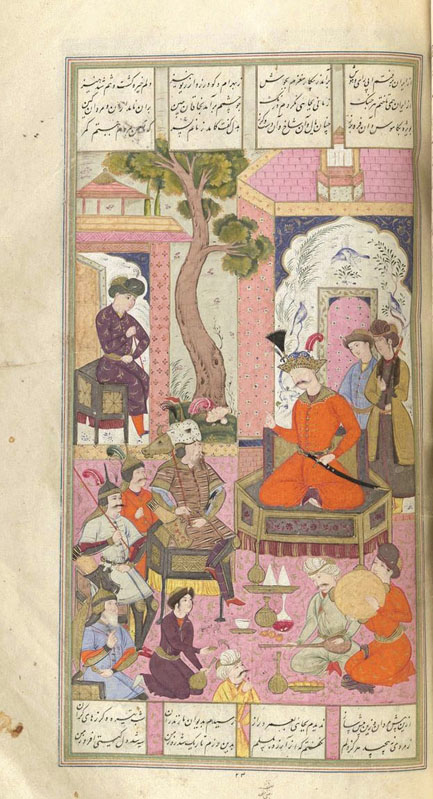Rostam Before Kay Ḵosrow After His Capture of the Ḵāqān
The painting is an unusual one for this episode. It shows Rostam dividing up the booty following his defat of the Turanians. But it appears to show the booty at the feet of the king Kay Ḵosrow, who was elsewhere at the time. The painting follows a very similar compositional format to folio 278, which suggests that Moʿin might not have had a prior example of this subject to guide him, and subsequently borrowed from another composition in the same manuscript.
Kay Ḵosrow is seated cross-legged on an elevated hexagonal throne in the upper right. He wears a long scarlet robe with gold buttons, a sword hanging from his belt, and a jewel studded crown adossed with feathers and the black aigrette of royalty. A ceremonial sword bearer and another servent stand behind him, in front of a multilobe arched panel painted with delicate foliage and birds. The panel, with a door in the center, is inset into a tiled hexagonal pavillion which continues upward to the top of the picture. Rostam, in his familiar leopard and tiger skin cuirass and ox-headed mace, is seated with his legs crossed on a smaller hexagonal seat before the shah. Clustered about him, in the left foreground, are three warriors in pointed helmets, a servant pouring wine, and a turbanned man leaning on a walking stick. Two musicians, one with a duff (tambourine), the other with a sehtār, are seated in the lower right. Vessels of food and drink are scattered about the central foreground. Another servant, perhaps a doorkeeper, is seated before the half open doorway to another small pavillion in the upper left. A large čenār tree grows between the two pavillions.
Painting : 27 x 16 cm. There are three lines of four column text above the painting, and two below. Kay Ḵosrow’s facial features have been obliterated, and Rostam’s have been severly damaged. Some other faces may have been retouched. The miniscule signature of Fażl ʿAli, raqam-e kamina fażl ʿali, appears twice, once just below the feet of Rostam, and again on the brickwork at the extreme top center. In addition, the signature of Moʿin, raqam zad kamina moʿin-e moṣavver, is inscribed in the lower margin. Attributed by Jackson and Yohannan to Fażl ʿAli, and by Robinson to Moʿin with the assistance of Fażl ʿAli. The execution level is inferior to most of the other Moʿin paintings in this manuscript, and by comparison with folio 278, one might construe that Fażl ʿAli played a greater role here than in some of the other paintings.
Painting references:
J&Y_1914, p.37 no.25 (not ill.).
Robinson, Cochran4_1972, p.78, no.25 (not ill.).
Cambridge Shahnameh Project
Text references: Warner, III, pp.232-33; Mohl, IV, pp.162ff..
Robert Eng
Last Updated: February 2, 2011 | Originally published: June 18, 2003
